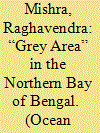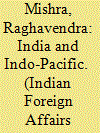|
|
|
Sort Order |
|
|
|
Items / Page
|
|
|
|
|
|
|
| Srl | Item |
| 1 |
ID:
145655


|
|
|
|
|
| Summary/Abstract |
The judgments in maritime delimitation cases involving Bangladesh and Myanmar (2012) and between Bangladesh and India (2014) have resulted in a “Grey Area” in the northern Bay of Bengal involving intersecting and overlapping rights and responsibilities in terms of the exclusive economic zone (EEZ) and continental shelf regimes. This article seeks to identify a functional solution for this Grey Area.
|
|
|
|
|
|
|
|
|
|
|
|
|
|
|
|
| 2 |
ID:
144479


|
|
|
|
|
| Summary/Abstract |
The relationship between India and the United States has transformed significantly since the Cold War, notwithstanding the denial regime imposed after the 1998 nuclear tests. In the complex 21st-century environment, both countries have articulated their strategic outreaches spanning the new geographical construct of a maritime configured Indo-Pacific. This article examines the coherence, correspondence and divergence in the approaches and the institutions of relevance in India's “Act East” and the US “Strategic Rebalance” through the “interest contiguity” paradigm. The salient aspects examined are the politico-diplomatic, economic and military security dimensions, by using a combinational of realist and rational choice theoretical prisms. The paper concludes that while there is a virtual coincidence of “interests’” between India and the US, their approaches and institutional frameworks are different in certain cases, driven by respective geopolitical, geoeconomic and geostrategic imperatives. The emerging positivity in the Indo–US relationship, like many other important engagements across the Indo-Pacific, will continue to contain a mix of cooperation and competition, which is not unusual and offers avenues for further strengthening of coordinated endeavours.
|
|
|
|
|
|
|
|
|
|
|
|
|
|
|
|
| 3 |
ID:
135805


|
|
|
|
|
| Summary/Abstract |
While the Pacific pole of the Indo-Pacific is important, the primacy of the Indian Ocean in the national strategic calculus is far more critical due to energy due to energy dependency on the Middle East, increasing economic linkage with Africa, and the security of major sea lines of communication passing through the western ocean.
The Indian strategic policy framework should factor the nuances of emerging multi-polarity, and deepening of vertical and horizontal intermeshing brought about by the globalization process. While the stance of ‘strategic autonomy’ remains inviolate, the tenets of maintaining equidistance and balance among the power centres may prove to be constraints. The simultaneous management of mutually opposing paradigm across the strategic threads of politics-diplomacy-economics-security could be best served by a ‘functional transitional approach’ instead of a rigid straight-line, single point of departure policy.
|
|
|
|
|
|
|
|
|
|
|
|
|
|
|
|
| 4 |
ID:
133675


|
|
|
|
|
| Publication |
2014.
|
| Summary/Abstract |
The Indian Ocean Region (IOR) presents a unique tapestry of correspondences and divergences, positive and negatives, in an era of flux with world order, most likely, on the cusp of a systemic reordering. The geo-strategic salience of this region, as part of a larger global maritime continuum, has also increased. Strategic hedging behaviour by major stakeholders, resident and non-resident alike; besides securitisation of geo-political discourse that focuses on competitive aspects also present distinctive challenges for evolving a cooperative framework tailored to regional needs. The key issues examined for obtaining a pan-regional politico-strategic rapprochement are the tenets of critical geopolitics, game theory, geography, context and the efficacy of existing multilateral mechanisms, especially Indian Ocean Rim Association (IORA). The overall aim is to examine the various intertwined threads for formulating an inclusive and multi-sectoral maritime security framework with an IOR contextualisation.
|
|
|
|
|
|
|
|
|
|
|
|
|
|
|
|
| 5 |
ID:
136646


|
|
|
|
|
| Summary/Abstract |
The global order is undergoing a churn and the general pointers forecast an era of a cataclysmic systemic change. The pronouncement of the “Rebalance to the Asia-Pacific”, indicating a shift in US strategic focus to Asia, has captured the imagination of the scholars and the analyst community alike. Within the prevailing nebulous and uncertain global architecture, this strategic recast by the dominant security provider has far-reaching implications. Considering the contextual underpinnings of various policy articulations and the geographic construct of this strategic reorientation, the maritime element would play a crucial role in this re-alignment of US strategic posture. This paper aims to deconstruct the maritime–military context of the US rebalance and draw out necessary implications for international, regional and Indian strategic calculus.
|
|
|
|
|
|
|
|
|
|
|
|
|
|
|
|
| 6 |
ID:
137443


|
|
|
|
|
| Summary/Abstract |
The USS Enterprise naval task group entry into the Indian Ocean during the closing stages of 1971 Indo-Pak Conflict led to further deterioration in the relations between India and the United States (US), and this estrangement lasted until the end of the Cold War. The US couched this show of force under the rubric of ensuring safety of American personnel caught up in a war zone. In India, however, this was seen as a coercive attempt to prop up a genocidal military regime. Using recently declassified official records from both sides, additional scholarly works on the 1971 conflict, and in light of the rapprochement in Indo-US relations, the article attempts to deconstruct the rhetoric and reality of this incident. It examines the prevailing politico-strategic environment, roles of diplomatic-military apparatus of major players, the mechanics of the naval deployment, and provides lessons for historical re-interpretation and the utility of seapower in the contemporary context.
|
|
|
|
|
|
|
|
|
|
|
|
|
|
|
|
| 7 |
ID:
136654


|
|
|
|
|
| Summary/Abstract |
Sir Creek, the 17th and last drainage branch of the river Indus, is a meandering riverine feature approximately 92 km (50 NM) long in the low-lying marshy region of Rann of Kutch. The Sir Creek boundary dispute between India and Pakistan is rooted in differing interpretations of the 1914 resolution passed by the Government of Bombay (GoB) or Bombay Residency. Pakistan claims that the international boundary runs along the east bank of Sir Creek, as depicted in the map appended to the GoB resolution (dotted line in Figure 1), whereas India claims that the boundary runs mid-channel on the ‘Thalweg’ principle, based on a more holistic interpretation of the related correspondence and the developments thereafter (dashed line in Figure 1).
|
|
|
|
|
|
|
|
|
|
|
|
|
|
|
|
|
|
|
|
|